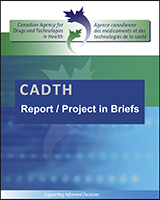Except where otherwise noted, this work is distributed under the terms of a Creative Commons Attribution-NonCommercial- NoDerivatives 4.0 International licence (CC BY-NC-ND), a copy of which is available at http://creativecommons.org/licenses/by-nc-nd/4.0/
NCBI Bookshelf. A service of the National Library of Medicine, National Institutes of Health.
CADTH Report / Project in Briefs [Internet]. Ottawa (ON): Canadian Agency for Drugs and Technologies in Health; 2011-2021.
Key Messages
S/D plasma may be considered as an alternative to standard plasma for certain patients who need a high volume of transfusions annually because they have one of the following conditions:
- TTP (both congenital and acquired forms)
- HUS with associated factor H deficiency
- or clotting factor deficiencies for which specific licensed concentrates may not be readily available (e.g., factor V, factor XI, factor XIII)
and they:
- have experienced an allergic reaction to frozen plasma, or
- have a pre-existing lung disorder, or
- need frozen plasma, but a blood group−compatible product is not available in a timely manner.
Technology
Solvent/detergent-treated human plasma (S/D plasma) is a form of virus-inactivated plasma product. The inclusion of the S/D treatment during the manufacturing process potentially reduces the risk of adverse events during plasma transfusion, including transmission of some viral infections, transfusion-related acute lung injury, and allergic reactions.
Condition
Three chronic hematological conditions were targeted by the research on the optimal use of S/D plasma:
- thrombotic thrombocytopenic purpura (TTP) (both congenital and acquired forms)
- hemolytic uremic syndrome (HUS) with associated factor H deficiency
- clotting factor deficiencies for which specific licensed concentrates may not be readily available (e.g., factor V, factor XI, factor XIII).
These conditions are of interest because patients affected by them typically receive a high volume of plasma annually.
Issue
Over the years, significant progress has been made in reducing the risk of pathogen transmission through blood transfusions. However, there remains a risk from both known and emerging pathogens.
S/D plasma is currently the only Health Canada-licensed, commercially available plasma component that includes an effective pathogen inactivation step — S/D treatment — in its manufacturing process. As a result, Canadian jurisdictions (except Quebec) must decide whether to add S/D plasma to the portfolio of plasma protein products that is distributed to hospitals through Canadian Blood Services.
The Canadian Agency for Drugs and Technologies in Health (CADTH) developed a recommendation on the optimal use of S/D plasma to support this decision-making process.
Methods
Research efforts to develop the recommendation for the optimal use of S/D plasma focused on:
- clinical evaluation (systematic review) comparing S/D plasma with standard plasma
- economic analysis and budget impact analysis on S/D plasma
- ethical assessment of issues related to the use of S/D plasma
- comments from a public call for feedback.
CADTH’s Panel of Experts used clinical, economic, and ethical evaluations, as well as stakeholder feedback, to develop the recommendation.
Results
The systematic review included 15 studies involving patients from randomized controlled trials and observational studies, and one multinational hemovigilance study. From a clinical perspective, there is no high-quality evidence to suggest that the use of S/D plasma is associated with more effective treatment of the hematologic conditions targeted by the recommendation.
The cost-effectiveness analysis indicated that S/D plasma treatment is more expensive than frozen plasma and produces only a small increase in quality-adjusted life-year (QALY) (a measure of the effectiveness of the treatment), whereas the incremental cost per QALY ($934,000) is very high. Based on traditionally accepted cost per QALY standards, the use of S/D plasma is not cost effective
From an ethical perspective, the precautionary principle (or the importance of taking due precaution to not cause harm to patients) requires that a potentially safer treatment be made available whenever possible.
Based on its assessment, and acknowledging that the risk associated with the transfusion of plasma products is low, the Panel of Experts recommends that S/D plasma be made available to patients at higher risk of adverse events because they need a high volume of plasma and face specific clinical circumstances.
For complete project information: www.cadth.ca
- DISCLAIMER: The information in this Project in Brief is intended to help health care decision‐makers, patients, health care professionals, health systems leaders, and policy‐makers make well‐informed decisions and thereby improve the quality of health care services. The information in this Project in Brief should not be used as a substitute for the application of clinical judgment in respect of the care of a particular patient or other professional judgment in any decision‐making process nor is it intended to replace professional medical advice. While CADTH has taken care in the preparation of the Project in Brief to ensure that its contents are accurate, complete, and up‐to‐date, CADTH does not make any guarantee to that effect. CADTH is not responsible for any errors or omissions or injury, loss, or damage arising from or as a result of the use (or misuse) of any information contained in or implied by the information in this Project in Brief.CADTH takes sole responsibility for the final form and content of this Project in Brief. The statements, conclusions, and views expressed herein do not necessarily represent the view of Health Canada or any provincial or territorial government. Production of this Project in Brief is made possible through a financial contribution from Health Canada.
- Guiding the Optimal Use of Solvent/Detergent-Treated Human Plasma - CADTH Report...Guiding the Optimal Use of Solvent/Detergent-Treated Human Plasma - CADTH Report / Project in Briefs
- Homologene neighbors for GEO Profiles (Select 125828291) (0)GEO Profiles
- Homologene neighbors for GEO Profiles (Select 83056052) (0)GEO Profiles
- Homologene neighbors for GEO Profiles (Select 83047480) (0)GEO Profiles
- Homologene neighbors for GEO Profiles (Select 12600716) (0)GEO Profiles
Your browsing activity is empty.
Activity recording is turned off.
See more...
